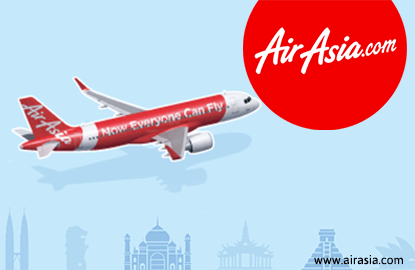
KUALA LUMPUR: AirAsia Bhd and its long-haul sister company AirAsia X Bhd (AAX) both reported higher numbers of passengers carried for the fourth quarter ended Dec 31, 2016 (4QFY16), in line with capacity growth during the three-month period.
However, in a statement yesterday, AAX said it remain cautious in 2017 as it anticipates a challenging environment despite a “success[ful] turnaround story last year”. Still, it remains confident about seeing sustainable growth going forward.
AirAsia carried 7% more passengers in 4QFY16, at 14.51 million versus 13.53 million a year ago, as capacity grew 5% to 17.09 million seats from 16.26 million seats.
The low-cost carrier, the largest in Asia, said its load factor was 85% in 4QFY16, up two percentage points (ppts) from 83% a year ago.
For FY16, the group carried 56.59 million passengers, up 12% from 50.68 million in FY15, while capacity grew 4% to 65.98 million seats from 63.34 million. Load factor for the full year was up 6ppts to 86% from 80% previously.
At its Malaysian ops, from where AirAsia derives most of its revenue, load factor was 87% in 4QFY16, up 2ppts from 85% a year ago, as demand exceeded the 2% year-on-year (y-o-y) increase in capacity. The number of passengers carried by Malaysia AirAsia came in higher by 5% at 6.76 million passengers in 4QFY16, from 6.47 million passengers a year ago.
Other than Malaysia, all of AirAsia’s associates overseas registered growth in passengers carried, except for Indonesia, which was undertaking capacity cuts while its management implemented a turnaround strategy.
Among these associates, AirAsia India charted the most notable growth in the latest quarter with 56% more passengers carried at 792,132, compared with 508,407 passengers last year. Capacity-wise, the unit, the smallest in the group, saw a 52% rise in the number of seats to 921,960 seats from 607,680 over two quarters, and posted a load factor of 86% in 4QFY16, up 2ppts from 84% in 4QFY15.
As at end-2016, AirAsia Group’s fleet comprised 172 aircraft (174 if two aircraft delivered to AirAsia Japan, which has yet to start operations, are included), versus 170 in FY15.
Over at the long-haul business, AAX carried 40% more passengers in the same quarter at 1.38 million, versus 985,739 passengers a year ago.
AAX said the improvement was in line with a 43% y-o-y growth in capacity to 1.71 million seats during the quarter, from 1.19 million seats, to cater to year-end holiday travel demand.
AAX’s quarterly passenger load factor, however, dropped 2ppts y-o-y to 81% from 83%, while available seat per kilometre (ASK) grew 44% y-o-y to 8.47 billion from 5.91 billion.
For the entire year, AAX carried 4.69 million passengers, up 30% from FY15’s 3.61 million passengers, as capacity grew 22% to 5.94 million seats from 4.85 million seats. Load factor for the entire FY16 also grew to 79% from 75% a year ago, as ASK increased 25% to 29.34 billion from 23.39 billion.